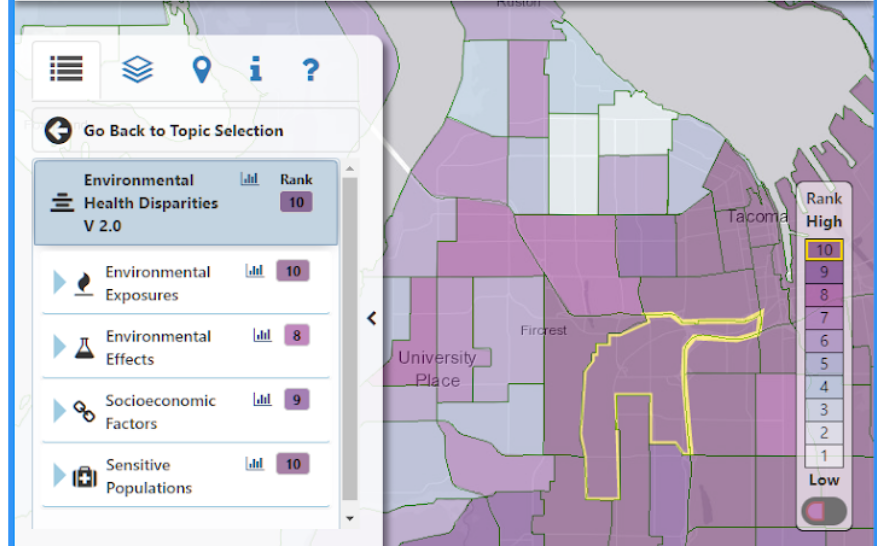Safe & Healthy Tacoma Threatened By Warehousing
The Planning and Development Service Department (PDS) of the City of Tacoma will soon make their environmental determination regarding the 2.5 million square foot mega e-commerce warehouse proposed in South Tacoma by Bridge Port Tacoma LLC (Bridge Industrial). For a project of this size and in such a critical area, residents and agencies have stated that further environmental and health reviews are clearly required. But so far the City has not indicated support for such measures.
The public’s right to health and safety are at stake. The developer estimated 5,000 new vehicle trips per day to be added to our streets and highways, but EarthJustice calculates 10-12,000 new vehicle trips per day, almost one-third heavy trucks. The increased traffic, including many semi-trucks, will worsen already congested roads of Tacoma and surrounding areas, endangering both commuters and residents.Tacomans have been organizing against this e-commerce warehouse for months, including a public education push on International Clean Air Day last September with the Clean Mobility Collective.
Placed in Tacoma’s poorest neighborhood, with the shortest life expectancy, highest levels of cardiovascular disease and low birth weight babies, this warehouse and its traffic will worsen such health problems. As part of the formerly redlined area, it has the highest percentages of Black, Hispanic, Asian, Indigenous and Mixed Race residents, deepening inequities and compounding systemic racism’s historic effects. The Washington State Department of Ecology officially rates South Tacoma as an “overburdened community” and the Washington State Department of Health ranks South Tacoma its worst ranking for environmental injustice and health inequities. Many of these impacts are in terrible trend with similar developments across the U.S. – where e-commerce related warehousing is being sited in low income, communities of color that are already overburdened with poor air quality.
EarthJustice calculates that, “applying the daily trip rates for fulfillment centers and parcel hub warehouses, the traffic study would have estimated that the project would produce 11,453 additional vehicle trips each weekday if the site is used as a distribution center (or “parcel hub”), or 12,088 additional vehicle trips each weekday if the site is used as a fulfillment center” instead of the 5,000 or so in the permit documents.
Bridge Industrial has been marketing the facility to e-commerce suppliers and has received expressions of interest from e-commerce tenants. According to the company, “the proximity of this site to so many key transit options, such as the Port of Tacoma and I-5, make it ideal for a variety of users meeting the ever-increasing demand for last-mile and next-day delivery.” Last year, the Clean Mobility Collective’s report found that the last-mile accounts for up to half of total delivery carbon emissions. Tacoma is one of many communities seeing that finding play out locally.
This warehouse complex would interrupt a residential community. Children & adults ride bicycles, walk and play near these streets that also include school crossings. Traffic is already congested in this area during peak travel times and can not support such a massive increase. Adding this much industrial traffic is counter to the City’s Vision Zero Plan.
While the warehouse is being touted as an opportunity for family wage job creation, that is unlikely to happen. Truck drivers and last mile delivery drivers are often not high-wage or union jobs. Some warehouse employers, such as Amazon, hold a reputation for terrible working conditions. Potentially using automated equipment in the warehouses could reduce the number of jobs created. The Teamsters No 28 are opposed to this proposed warehouse complex as well as United Food & Commercial Workers Local 367.
This land is one of the last open green areas in South Tacoma, with four wetlands connecting to salmon-spawning streams and Puget Sound. The proposed buildings alone will be as big as 50 football fields, and almost another 70 acres will be paved on top of South Tacoma Aquifer, our city’s backup water (125 acres of new impermeable surface total). Studded with mature trees and grasses, vegetation stabilizes and purifies this polluted former railroad and industrial land (12 acres are still an active superfund site, with 91 acres moderately polluted, best left undisturbed).
Other troubling concerns include the still-muddy understandings of the South Tacoma Aquifer. The construction will pave over all but 25 acres of the 150 acres of green space nearby. As climate change continues, we can expect less glacier melt, more summers without rain, and more droughts, causing us to rely more heavily on our aquifers for drinking water. Pollution will also be worsened by a proposal to heat this huge mega warehouse by using 52 gas-fired heaters, increasing on-site leak and explosion risk.
It is worrisome that the company proposing the project (rather than independent experts’) are guiding Tacoma’s evaluation of the expected impact on our environment. We at 350Tacoma have found that, for a full year Bridge Industrial did not conduct a comprehensive tree survey nor a careful biological survey of the Biodiversity Critical Areas, instead repeatedly resubmitting incomplete work.
The most recent air quality analysis uses the flawed rationale that the seasonal impact of wildfires and residential fireplaces always prevents the impact of new vehicles from even being calculated. The traffic study is similarly flawed because truck drivers will more often use apps to access the warehouse complex, right through residential neighborhoods.
The City Council has a role in representing Tacomans’ best interest — in this case, that would be arguing for an Environmental Impact Statement and Health Impact Statement in line with the experts at the US Environmental Protection Agency, WA Department of Ecology, WA Department of Health, and Tacoma-Pierce County Health Department. Council Members can bring attention to the incomplete and inexpert information under review. They can advocate for protecting our health and reversing environmental justice and health inequities, not deepening them.
Learn more here and take action in solidarity with Tacoma by sharing this post.
– 350Tacoma
